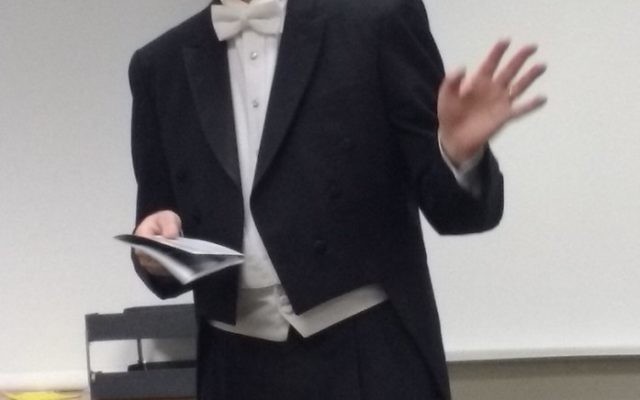DeKalb Orchestra Pays Tribute to Jewish Themes
By Benjamin Kweskin
The DeKalb Symphony Orchestra paid homage to two Jewish conductors, as well as Mozart and Brahms, at a concert Tuesday, May 24.
The DSO’s conductor, Fyodor Cherniavsky, born in London and educated at Cambridge and the Guildhall School of Music and Drama, hails from a line of musicians: his great-grandfather Avrum was a youth orchestra conductor in Ukraine during the late 1800s.
Cherniavsky presented a short lecture before the concert at Georgia Perimeter College’s Marvin Cole Auditorium. Briefly touching on the evening’s four pieces, he shared historical background and anecdotes about the music. Occasionally playing piano to highlight certain points, the maestro made it clear that the selections were labors of love.

The first piece in the program was Serge Prokofiev’s “Overture on Hebrew Themes, Op. 34,” previously performed by the DSO. The modernist yet neo-classical style of Prokofiev is part “satirical,” part “acerbic, with crunchy melodies,” Cherniavsky said.
Commissioned by the clarinetist for the U.S.-based Russian-Jewish Zimro Ensemble while on tour in 1919, the overture incorporates vignettes of klezmer throughout. In 1934, Prokofiev composed an orchestral version that is “both fun and accessible,” though he is better known for his difficult, textured and layered pieces.
Mozart’s “Jupiter Symphony,” his last, was the second performance of the night. Also known as “Symphony No. 41 in C Major,” this modern, “highly constructed but exciting and happy” piece consists of various themes that are combined at the end of a long, complex symphony.
The third movement from Brahms’ “String Quartet No. 1, Op. 51” led the second half of the evening. The piece was arranged by Marty Matteson, a DSO viola player, and had never been played by the DSO for an audience.
The final piece was Ernest Bloch’s “Schelomo: Hebraic Rhapsody,” which Cherniavsky called an “extraordinary and extremely challenging piece, especially for soloists.” It’s dark and dramatic and is rarely performed.
Cherniavsky said the Jewish, Swiss-born Bloch wrote the piece in 1915 and 1916 when he was searching for his musical and national identities. The music engages the audience and performers and reflects Bloch’s struggles with his faith and ideals.
“Schelomo” comes from the Hebrew word for Solomon. The solo cellist takes on the persona of King Solomon, while the orchestra personifies the world at large. The tension between them can be heard in the dramatic and at times obviously Middle Eastern composition, which the conductor said is “fragmented but organic.”
Reviewed by a famous critic in 1921, Bloch “reached the perfection of his music. … The violoncello with its ample breadth of phrasing, now melodic and with moments of superb lyricism, now declamatory and with robustly dramatic lights and shades, lends itself to a reincarnation of Solomon and all his glory. … The orchestral palpitates in all colors of the rainbow; from the vigorous and transparent orchestration there emerge waves of sound that seem to soar upward in stupendous vortices and fall back in a shower of myriads of iridescent drops.”
Cherniavsky said that when the orchestra finished playing the Bloch piece for the first time, the response was a collective “What is this?” because it seemed like a different language.
Even Cherniavsky did not initially know what to make of it, he said. “At first it did not move me, but now I recognize it is an amazing piece.”
He asked the featured cellist, Charae Kruger, what she wanted to perform and she said that the Bloch piece was always on her bucket list. Though the maestro initially hesitated, the DSO’s maiden performance was well received: Kruger’s rendering was effortless, and she and the orchestra received a standing ovation by the nearly full auditorium.





comments